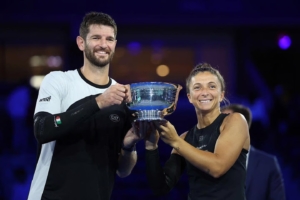Ah! Doubles Really Is a Different Game
Ah! Doubles Really Is a Different Game
At this year’s U.S. Open mixed doubles, Sara Errani and Andrea Vavassori reminded everyone that doubles is not just singles with four players jammed on the court—it’s an entirely different sport.
The Italian specialists—last year’s champions—are back again, dismantling some of the biggest singles names. Rybakina and Fritz? Gone. Rublev and Muchová? Outclassed. And with only a semifinal run so far, Errani and Vavassori have already pocketed more money than they earned winning the entire event last year.
The irony is sharp: the event was packaged as a showcase for singles stars, but it’s the doubles masters who are writing the story and cashing the checks.
Why Doubles Specialists Dominate
-
The Magic Diamond – Picture a diamond laid over the court, linking the four players. That diamond marks out the key sections where nearly 80% of balls are played at every level. Great doubles teams shift the diamond with each shot, always covering the hot zones, closing seams, and shrinking angles. Singles players often miss it—and leave space that doubles experts devour.
-
Craft Over Power – Singles stars try to blast their way through. Doubles specialists rely on placement, anticipation, and sharp angles.
-
Net Control – In doubles, the net is everything. Vavassori’s wingspan and Errani’s timing turn floating balls into easy winners.
-
Partnership as Choreography – Doubles isn’t improvisation. It’s synchronized movement—like Torvill and Dean on ice, only with rackets.
Badge Lessons
The same story unfolded last Saturday with two Manly teams in the Sydney Badge semifinals.
-
In Division 1, two young singles guns came out banging from the baseline. Nick and Rimmo stayed calm, worked the diamond, and took charge at the net. Result: four sets won, match sealed.
-
In Division 10, Issac and Barnaby committed fully to the diamond, keeping themselves anchored in the right zones every point. The payoff: three sets, including the clutch decider that delivered the tie.
Different divisions, same truth: doubles is a different game.
A Crowd’s Education
At the U.S. Open, fans came for the franchise names. Ticket prices were trimmed to fill the stands.
What the crowd got instead was a masterclass in doubles.
It wasn’t just tennis—it was Torvill and Dean on a court: precision, timing, and coordinated movement. The fans expected fireworks. They walked away talking about geometry, poaching, and anticipation.
How to Play Winning Doubles
To win in doubles, stop playing singles with a partner. Start playing doubles:
-
Play the Diamond – Shift with your partner on every shot. Protect the middle, close the angles, and make opponents hit the low-percentage ball.
-
Serve & Return With Purpose – Serves should feed your partner. Returns should be crosscourt, low, or lobbed to disrupt formations and keep the net player honest.
-
Stay Mentally Sharp – Keep your eyes outward on cues and patterns. Use quick rituals—like a simple ball squeeze—to reset and stay calm under pressure.
-
ABC: Always Be Closing – Move forward behind deep shots, poach the floaters, and keep opponents under constant net pressure.
Whisperer Wrap
This year’s U.S. Open mixed doubles was designed as a showcase for singles stars. Instead, it has become a clinic on the geometry and psychology of doubles. Errani and Vavassori—last year’s champions and already richer semifinalists this year—are proving the point.
From Flushing Meadows to Sydney Badge, the lesson is the same:
Doubles really is a different game. And those who master the diamond, the net, and the partnership—always win.
And of course, it helps if you have a consistent volley!

Source: Getty Images
PS: Errani and Vavassori didn’t just make the semis — they won it in classic doubles fashion: 6/3, 5/7, 10/6 in the match tiebreaker. Another reminder that when the pressure’s highest, the doubles specialists know exactly how to finish the job.



